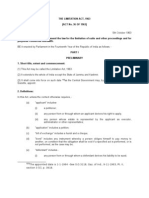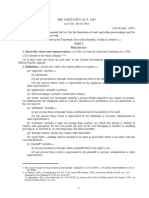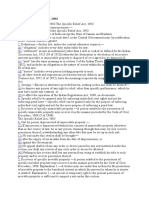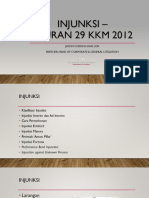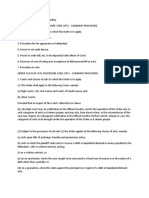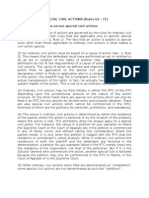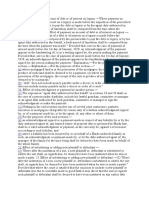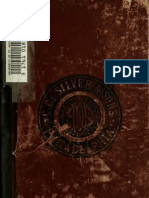0 ratings0% found this document useful (0 votes)
45 viewsThe Limitation Act, 1963
The Limitation Act, 1963
Uploaded by
Kapil KaroliyaThe Limitation Act 1963 establishes limitation periods for filing legal claims and lawsuits in India. Some key points:
- It establishes defined time periods (limitation periods) for different types of civil suits, appeals, and applications. Once the limitation period expires, lawsuits cannot be filed even if limitation was not raised as a defense.
- There are provisions for extending limitation periods in certain circumstances, such as when the plaintiff was a minor or legally incapacitated, or if the court was closed on the last day of the limitation period.
- The Act defines various legal terms and establishes rules around when a lawsuit is considered filed, such as when a plaint is submitted to the court officer.
-
Copyright:
© All Rights Reserved
Available Formats
Download as DOCX, PDF, TXT or read online from Scribd
The Limitation Act, 1963
The Limitation Act, 1963
Uploaded by
Kapil Karoliya0 ratings0% found this document useful (0 votes)
45 views4 pagesThe Limitation Act 1963 establishes limitation periods for filing legal claims and lawsuits in India. Some key points:
- It establishes defined time periods (limitation periods) for different types of civil suits, appeals, and applications. Once the limitation period expires, lawsuits cannot be filed even if limitation was not raised as a defense.
- There are provisions for extending limitation periods in certain circumstances, such as when the plaintiff was a minor or legally incapacitated, or if the court was closed on the last day of the limitation period.
- The Act defines various legal terms and establishes rules around when a lawsuit is considered filed, such as when a plaint is submitted to the court officer.
-
Original Description:
Original Title
zzzzz
Copyright
© © All Rights Reserved
Available Formats
DOCX, PDF, TXT or read online from Scribd
Share this document
Did you find this document useful?
Is this content inappropriate?
The Limitation Act 1963 establishes limitation periods for filing legal claims and lawsuits in India. Some key points:
- It establishes defined time periods (limitation periods) for different types of civil suits, appeals, and applications. Once the limitation period expires, lawsuits cannot be filed even if limitation was not raised as a defense.
- There are provisions for extending limitation periods in certain circumstances, such as when the plaintiff was a minor or legally incapacitated, or if the court was closed on the last day of the limitation period.
- The Act defines various legal terms and establishes rules around when a lawsuit is considered filed, such as when a plaint is submitted to the court officer.
-
Copyright:
© All Rights Reserved
Available Formats
Download as DOCX, PDF, TXT or read online from Scribd
Download as docx, pdf, or txt
0 ratings0% found this document useful (0 votes)
45 views4 pagesThe Limitation Act, 1963
The Limitation Act, 1963
Uploaded by
Kapil KaroliyaThe Limitation Act 1963 establishes limitation periods for filing legal claims and lawsuits in India. Some key points:
- It establishes defined time periods (limitation periods) for different types of civil suits, appeals, and applications. Once the limitation period expires, lawsuits cannot be filed even if limitation was not raised as a defense.
- There are provisions for extending limitation periods in certain circumstances, such as when the plaintiff was a minor or legally incapacitated, or if the court was closed on the last day of the limitation period.
- The Act defines various legal terms and establishes rules around when a lawsuit is considered filed, such as when a plaint is submitted to the court officer.
-
Copyright:
© All Rights Reserved
Available Formats
Download as DOCX, PDF, TXT or read online from Scribd
Download as docx, pdf, or txt
You are on page 1of 4
The Limitation Act, 1963
The Limitation Act, 1963
1. Short title, extent and commencement.—
(1) This Act may be called the Limitation Act, 1963.
(2) It extends to the whole of India except, the State of Jammu and Kashmir.
(3) It shall come into force on such date1 as the Central Government may, by notification
in the Official Gazette, appoint.
2. Definitions.—In this Act, unless the context otherwise requires,—
(a) “applicant” includes—
(i) a petitioner;
(ii) any person from or through whom an applicant derives his right to apply;
(iii) any person whose estate is represented by the applicant as executor, administrator or
other representative;
(b) “application” includes a petition;
(c) “bill of exchange” includes a hundi and a cheque;
(d) “bond “ includes any instrument whereby a person obliges himself to pay money to
another, on condition that the obligation shall be void if a specified act is performed, or is
not performed, as the case may be;
(e) “defendant” includes—
(i) any person from or through whom a defendant derives his liability to be sued;
(ii) any person whose estate is represented by the defendant as executor, administrator or
other representative;
(f) “easement” includes a right not arising from contract, by which one person is entitled
to remove and appropriate for his own profit any part of the soil belonging to another or
anything growing in, or attached to, or subsisting upon, the land of another;
(g) “foreign country” means any country other than India;
(h) “good faith”— nothing shall be deemed to be done in good faith which is not done
with due care and attention;
(i) “plaintiff” includes—
(i) any person from or through whom a plaintiff derives his right to sue;
(ii) any person whose estate is represented by the plaintiff as executor, administrator or
other representative;
(j) “period of limitation” means the period of limitation prescribed for any suit, appeal or
application by the Schedule, and “prescribed period” means the period of limitation
computed in accordance with the provisions of this Act;
(k) “promissory note” means any instrument whereby the maker engages absolutely to
pay a specified sum of money to another at a time therein limited, or on demand, or at
sight;
(l) “suit” does not include an appeal or an application;
(m) “tort” means a civil wrong which is not exclusively the breach of a contract or the
breach of a trust;
(n) “trustee” does not include a benamidar, a mortgagee remaining in possession after the
mortgage has been satisfied or a person in a wrongful possession without title.
3. Bar of limitation.—
(1) Subject to the provisions contained in sections 4 to 24 (inclusive), every suit
instituted, appeal preferred, and application made after the prescribed period shall be
dismissed, although limitation has not been set up as a defence.
(2) For the purposes of this Act— (2) For the purposes of this Act—"
(a) a suit is instituted— (a) a suit is instituted—"
(i) in an ordinary case, when the plaint is presented to the proper officer; (i) in an ordinary
case, when the plaint is presented to the proper officer;"
(ii) in the case of a pauper, when his application for leave to sue as a pauper is made; and
(ii) in the case of a pauper, when his application for leave to sue as a pauper is made; and"
(iii) in the case of a claim against a company which is being wound up by the court, when
the claimant first sends in his claim to the official liquidator; (iii) in the case of a claim
against a company which is being wound up by the court, when the claimant first sends in
his claim to the official liquidator;"
(b) any claim by way of a set off or a counter claim, shall be treated as a separate suit and
shall be deemed to have been instituted— (b) any claim by way of a set off or a counter
claim, shall be treated as a separate suit and shall be deemed to have been instituted—"
(i) in the case of a set off, on the same date as the suit in which the set off is pleaded; (i)
in the case of a set off, on the same date as the suit in which the set off is pleaded;"
(ii) in the case of a counter claim, on the date on which the counter claim is made in
court; (ii) in the case of a counter claim, on the date on which the counter claim is made
in court;"
(c) an application by notice of motion in a High Court is made when the application is
presented to the proper officer of that court.
4. Expiry of prescribed period when court is closed.—Where the prescribed period for
any suit, appeal or application expires on a day when the court is closed, the suit, appeal
or application may be instituted, preferred or made on the day when the court reopens.
Explanation.— A court shall be deemed to be closed on any day within the meaning of
this section if during any part of its normal working hours it remains closed on that day.
5 Extension of prescribed period in certain cases. —Any appeal or any application, other
than an application under any of the provisions of Order XXI of the Code of Civil
Procedure, 1908 (5 of 1908), may be admitted after the prescribed period, if the appellant
or the applicant satisfies the court that he had sufficient cause for not preferring the
appeal or making the application within such period. Explanation.— The fact that the
appellant or the applicant was misled by any order, practice or judgment of the High
Court in ascertaining or computing the prescribed period may be sufficient cause within
the meaning of this section.
6. Legal disability.—
(1) Where a person entitled to institute a suit or make an application for the execution of a
decree is, at the time from which the prescribed period is to be reckoned, a minor or
insane, or an idiot, he may institute the suit or make the application within the same
period after the disability has ceased, as would otherwise have been allowed from the
time specified therefor in the third column of the Schedule.
(2) Where such person is, at the time from which the prescribed period is to be reckoned,
affected by two such disabilities, or where, before his disability has ceased, he is affected
by another disability, he may institute the suit or make the application within the same
period after both disabilities have ceased, as would otherwise have been allowed from the
time so specified.
(3) Where the disability continues up to the death of that person, his legal representative
may institute the suit or make the application within the same period after the death, as
would otherwise have been allowed from the time so specified.
(4) Where the legal representative referred to in sub-section (3) is, at the date of the death
of the person whom he represents, affected by any such disability, the rules contained in
sub-sections (1) and (2) shall apply.
(5) Where a person under disability dies after the disability ceases but within the period
allowed to him under this section, his legal representative may institute the suit or make
the application within the same period after the death, as would otherwise have been
available to that person had he not died. Explanation.—For the purposes of this section,
‘minor’ includes a child in the womb.
7. Disability of one of several persons.—Where one of several persons jointly entitled to
institute a suit or make an application for the execution of a decree is under any such
disability, and a discharge can be given without the concurrence of such person, time will
run against them all; but, where no such discharge can be given, time will not run as
against any of them until one of them becomes capable of giving such discharge without
the concurrence of the others or until the disability has ceased. Explanation I.— This
section applies to a discharge from every kind of liability, including a liability in respect
of any immovable property. Explanation II.— For the purposes of this section, the
manager of a Hindu undivided family governed by the Mitakshara law shall be deemed to
be capable of giving a discharge without the concurrence of the other members of the
family only if he is in management of the joint family property.
You might also like
- Design Qualification Sample ProtocolDocument16 pagesDesign Qualification Sample ProtocolMatheus Parise Fescina100% (4)
- Reptile Pathology - Necropsy TechniquesDocument70 pagesReptile Pathology - Necropsy TechniquesJustine Paola Delos Santos100% (1)
- Simple Guide for Drafting of Civil Suits in IndiaFrom EverandSimple Guide for Drafting of Civil Suits in IndiaRating: 4.5 out of 5 stars4.5/5 (4)
- Summary Suits - Order 37Document15 pagesSummary Suits - Order 37Dhaval Gohel100% (1)
- Glance of The Limitation Act 1908 Typing by LutfurDocument7 pagesGlance of The Limitation Act 1908 Typing by LutfurLowlyLutfur100% (1)
- Earnest Money ContractDocument3 pagesEarnest Money ContractKapil KaroliyaNo ratings yet
- Agreement For Purchase & Sale of Real Estate (Subject To Transaction)Document1 pageAgreement For Purchase & Sale of Real Estate (Subject To Transaction)Kapil Karoliya100% (1)
- Suras To Pray in 5 Daily Salah PrayersDocument19 pagesSuras To Pray in 5 Daily Salah Prayersdukor50No ratings yet
- Limitation ActDocument25 pagesLimitation Actmithun7No ratings yet
- Limitation Act 1963Document22 pagesLimitation Act 1963Malla Reddy AVNo ratings yet
- Limitation Act 1963Document19 pagesLimitation Act 1963Natasha SharmaNo ratings yet
- 26 26 The Limitation Act 1963Document35 pages26 26 The Limitation Act 1963Pankaj KundraNo ratings yet
- 51 43 The Limitation ActDocument31 pages51 43 The Limitation ActtonyvinayakNo ratings yet
- The Limitation Act 1963Document30 pagesThe Limitation Act 1963alkca_lawyerNo ratings yet
- The Limitation Act 1963Document21 pagesThe Limitation Act 1963Swastik SinghNo ratings yet
- Limitation ActDocument19 pagesLimitation Actllb19019.bappyNo ratings yet
- The Limitation Act, 1908 (Act No. Ix of 1908) PDFDocument8 pagesThe Limitation Act, 1908 (Act No. Ix of 1908) PDFRaheem Ullah KakarNo ratings yet
- The Limitation ActDocument27 pagesThe Limitation ActLakshyaNo ratings yet
- Limitation Act 1963Document36 pagesLimitation Act 1963Rajbir kaurNo ratings yet
- Limitation Bare Act LatestDocument9 pagesLimitation Bare Act LatestMonikaNo ratings yet
- Limitation Act PDFDocument40 pagesLimitation Act PDFsmritiNo ratings yet
- The Limitation Act 1908Document28 pagesThe Limitation Act 1908Asif Masood Raja100% (2)
- The Limitation Act, 1908: (ACT NO. IX of 1908)Document14 pagesThe Limitation Act, 1908: (ACT NO. IX of 1908)aminur rahmanNo ratings yet
- The Limitation Act 1963Document24 pagesThe Limitation Act 1963SomaNo ratings yet
- Limitation ActDocument21 pagesLimitation Actguru prasad50% (2)
- Limitation Act 1963Document24 pagesLimitation Act 1963Dikshagoyal1230% (1)
- Law of Limitations Act 1963 PDFDocument24 pagesLaw of Limitations Act 1963 PDFPravin ThaparNo ratings yet
- 12 - Chapter 6 PDFDocument35 pages12 - Chapter 6 PDFRaja Churchill DassNo ratings yet
- Limitation of Suits, Appeals and ApplicationsDocument16 pagesLimitation of Suits, Appeals and ApplicationsSaurabh BhardwajNo ratings yet
- HE Imitation CTDocument9 pagesHE Imitation CTstarkishNo ratings yet
- CPC Limitation Act - Pavitra Sudhir Kanchan - 21011471Document16 pagesCPC Limitation Act - Pavitra Sudhir Kanchan - 21011471shianasareen8No ratings yet
- Limitation ActDocument15 pagesLimitation ActSubarna palNo ratings yet
- LLB 5TH Sem CPC Unit 5Document8 pagesLLB 5TH Sem CPC Unit 5Duby ManNo ratings yet
- The Specific Relief Act, 1963Document2 pagesThe Specific Relief Act, 1963Kapil KaroliyaNo ratings yet
- Limitation ActDocument7 pagesLimitation ActAnurag YadavNo ratings yet
- The Limitation Act 1908 Zafar Iqbal KalanauriDocument3 pagesThe Limitation Act 1908 Zafar Iqbal KalanauriUsman AsifNo ratings yet
- 56 Limitation Act Part 5Document27 pages56 Limitation Act Part 5Anusha V RNo ratings yet
- UCC3Document4 pagesUCC3TRISTARUSA100% (8)
- Posc ActDocument7 pagesPosc ActPrem ChandNo ratings yet
- Limitations Act 1908Document16 pagesLimitations Act 1908mahasina bannaNo ratings yet
- LIMITATIONDocument4 pagesLIMITATIONrijasrahim1020No ratings yet
- Limitation and Court Fees ActDocument22 pagesLimitation and Court Fees ActSunny AamNo ratings yet
- The Specific Relief Act, 1963Document12 pagesThe Specific Relief Act, 1963sniper from hellNo ratings yet
- Topic 1 Part BDocument12 pagesTopic 1 Part BJ Enn WooNo ratings yet
- Recovery SuitDocument10 pagesRecovery SuitAnkitTiwariNo ratings yet
- LLB 4 Civil Procedure IDocument6 pagesLLB 4 Civil Procedure INasifa ZaweddeNo ratings yet
- Modes of Execution of Various Types of DecreesDocument4 pagesModes of Execution of Various Types of Decreesamanullah chacharNo ratings yet
- Subject - IIIDocument7 pagesSubject - IIIVelentinaNo ratings yet
- InjunctionDocument36 pagesInjunctionBatrisyia NurNo ratings yet
- Summary ProceedingDocument4 pagesSummary ProceedingDeepanshu ShakargayeNo ratings yet
- Rule 62 To 71 Special Civil ActionsDocument44 pagesRule 62 To 71 Special Civil ActionsAlvin ClaridadesNo ratings yet
- Djs Objection Set BDocument3 pagesDjs Objection Set BkeerthivhashanNo ratings yet
- LN145 2019Document29 pagesLN145 2019faithNo ratings yet
- Effect of Fraud or MistakeDocument1 pageEffect of Fraud or Mistakeshreesindhu54No ratings yet
- Pauper SuitDocument4 pagesPauper Suitsaatvik khurana100% (1)
- Limitation Act 1963Document3 pagesLimitation Act 1963Agastya ChauhanNo ratings yet
- Provisions - Insolvency MatterDocument3 pagesProvisions - Insolvency MatterAmir AkmalNo ratings yet
- Special Civil ActionsDocument23 pagesSpecial Civil ActionsCarmel LouiseNo ratings yet
- The Criminal Law Amendment Ordinance, 1944Document11 pagesThe Criminal Law Amendment Ordinance, 1944Soumyadeep MitraNo ratings yet
- The Charitable Religious Trusts Act 1920 PDFDocument8 pagesThe Charitable Religious Trusts Act 1920 PDFPrakash GrNo ratings yet
- Civil Procedure Code-Vith Semester Study Material of Unit - V Teacher - Shagufta Yasmin Order Xxxviii - Arrest and Attachment Before JudgementDocument11 pagesCivil Procedure Code-Vith Semester Study Material of Unit - V Teacher - Shagufta Yasmin Order Xxxviii - Arrest and Attachment Before JudgementMerlin KNo ratings yet
- American Convention on Human Rights (Pact of San José)From EverandAmerican Convention on Human Rights (Pact of San José)No ratings yet
- The Specific Relief Act, 1963Document2 pagesThe Specific Relief Act, 1963Kapil KaroliyaNo ratings yet
- Effect of Payment On Account of Debt or of Interest On LegacyxxxxxDocument3 pagesEffect of Payment On Account of Debt or of Interest On LegacyxxxxxKapil KaroliyaNo ratings yet
- Agreement To Sell Real Estate: Store Data Retrieve Data Clear Form ExitDocument3 pagesAgreement To Sell Real Estate: Store Data Retrieve Data Clear Form ExitKapil KaroliyaNo ratings yet
- Loan Agreement: 1. Parties of The AgreementDocument3 pagesLoan Agreement: 1. Parties of The AgreementKapil KaroliyaNo ratings yet
- Purchase Sale ContractDocument7 pagesPurchase Sale ContractKapil Karoliya100% (2)
- Loan Agreement FormDocument34 pagesLoan Agreement FormKapil KaroliyaNo ratings yet
- Form 26AS: Annual Tax Statement Under Section 203AA of The Income Tax Act, 1961Document4 pagesForm 26AS: Annual Tax Statement Under Section 203AA of The Income Tax Act, 1961Kapil KaroliyaNo ratings yet
- Amount Rs. This Forms Part of The PERSONAL LOAN Agreement Executed Between - Insert The NameDocument13 pagesAmount Rs. This Forms Part of The PERSONAL LOAN Agreement Executed Between - Insert The NameKapil KaroliyaNo ratings yet
- Final Submission Kapil Law of ElectionDocument51 pagesFinal Submission Kapil Law of ElectionKapil KaroliyaNo ratings yet
- KPMG Flash News Raj Dadarkar and Associates 4zDocument3 pagesKPMG Flash News Raj Dadarkar and Associates 4zKapil KaroliyaNo ratings yet
- Shadow World The Jade DaggerDocument10 pagesShadow World The Jade Daggerbob100% (1)
- Intro To Psychological AssessmentDocument4 pagesIntro To Psychological AssessmentCxziNo ratings yet
- GD & Question Bank of Blue Dart 2014Document2 pagesGD & Question Bank of Blue Dart 2014AkritiAggarwalNo ratings yet
- Assignment On: Fareast International UniversityDocument11 pagesAssignment On: Fareast International UniversityAysha SultanaNo ratings yet
- ZI WEI DOU SHU - Ancient Chinese Art of Predicting Your DestinyDocument5 pagesZI WEI DOU SHU - Ancient Chinese Art of Predicting Your DestinypptmnltNo ratings yet
- Digital Lesson Plan Model SemeeyathDocument4 pagesDigital Lesson Plan Model Semeeyathapi-361298866No ratings yet
- SW 1 Man QB 1Document3 pagesSW 1 Man QB 1Jay KshirsagarNo ratings yet
- Gibson Afford AncesDocument7 pagesGibson Afford AncesAda DarmonNo ratings yet
- Project Financing & ApprDocument25 pagesProject Financing & ApprsiesfriendsNo ratings yet
- (Domotica) - X10 Communications Protocol and Power Line Interfaces psc04 and psc05 PDFDocument11 pages(Domotica) - X10 Communications Protocol and Power Line Interfaces psc04 and psc05 PDFALfredo ROldanNo ratings yet
- Quadratic EquationDocument14 pagesQuadratic EquationAshTurb1342UNo ratings yet
- WHLP 1Document3 pagesWHLP 1Jerald Pelasor FloritaNo ratings yet
- (Studies in Penal Theory and Penal Ethics) A.P. Simester, Andreas Von Hirsch-Crimes, Harms, and Wrongs - On The Principles of Criminalisation-Hart Publishing (2011) PDFDocument259 pages(Studies in Penal Theory and Penal Ethics) A.P. Simester, Andreas Von Hirsch-Crimes, Harms, and Wrongs - On The Principles of Criminalisation-Hart Publishing (2011) PDFAsep KusnaliNo ratings yet
- UntitlevgjbfgdDocument2 pagesUntitlevgjbfgdHamza MudassirNo ratings yet
- Satires of Decimus Juveul Hamilton SystemDocument274 pagesSatires of Decimus Juveul Hamilton SystemJack Jones100% (1)
- Å Pakistan - A Study in National Integration PDFDocument296 pagesÅ Pakistan - A Study in National Integration PDFMaisamNo ratings yet
- William Blake The Marriage of Heaven and Hell PDFDocument30 pagesWilliam Blake The Marriage of Heaven and Hell PDFBiaNo ratings yet
- Brochure 2 EditDocument2 pagesBrochure 2 EditMiki AntonNo ratings yet
- Trailer Hire AgreementDocument4 pagesTrailer Hire AgreementZama SinkalaNo ratings yet
- Module 1-Overview - Starting A Business-The No Nonsense GuideDocument13 pagesModule 1-Overview - Starting A Business-The No Nonsense Guidejopeco2010No ratings yet
- Soal Try Out Paket ADocument17 pagesSoal Try Out Paket AGuno Ardi WibowoNo ratings yet
- I Am NOT A Vampire!Document39 pagesI Am NOT A Vampire!Martin LindbergNo ratings yet
- Chapter Introduction Lesson 1: Sexual Reproduction and Meiosis Asexual ReproductionDocument28 pagesChapter Introduction Lesson 1: Sexual Reproduction and Meiosis Asexual ReproductionMaram YousefNo ratings yet
- Escorts LTDDocument34 pagesEscorts LTDSheersh jainNo ratings yet
- Interpretation of ContractsDocument2 pagesInterpretation of ContractsGiulía O'HaræNo ratings yet
- Islamic Banking and Finance in Sri Lanka: A Paradigm of Success by Riyazi FarookDocument2 pagesIslamic Banking and Finance in Sri Lanka: A Paradigm of Success by Riyazi FarookRiyazi FarookNo ratings yet
- Learning Management Systems: An Overview: August 2019Document8 pagesLearning Management Systems: An Overview: August 2019Mihai JalbăNo ratings yet













